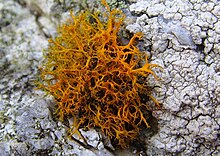
The Teloschistaceae are a large family of mostly lichen-forming fungi belonging to the class Lecanoromycetes in the division Ascomycota. The family has a cosmopolitan distribution, although its members occur predominantly in temperate regions. Most members are lichens that either live on rock or on bark, but about 40 species are lichenicolous – meaning they are non-lichenised fungi that live on other lichens. Many members of the Teloschistaceae are readily identifiable by their vibrant orange to yellow hue, a result of their frequent anthraquinone content. The presence of these anthraquinone pigments, which confer protection from ultraviolet light, enabled this group to expand from shaded forest habitats to harsher environmental conditions of sunny and arid ecosystems during the Late Cretaceous.
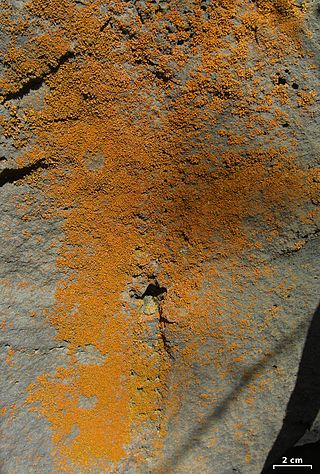
Xanthomendoza is a genus of small, bright orange foliose lichens with lecanorine apothecia. It is in the family Teloschistaceae. Members of the genus are commonly called sunburst lichens or orange lichens because of their bright orange color.
Seirophora is a genus of lichen-forming fungi in the family Teloschistaceae. It has eight species. The genus was circumscribed by Czech lichenologist Josef Poelt in 1983, with Seirophora magara assigned as the type species. Several species were transferred to Seirophora in 2004 when the genus was emended by Patrik Frödén and Per Lassen to include some species segregated from Teloschistes.

Teloschistes chrysophthalmus, sometimes referred to as the gold-eye lichen or golden-eye, is a fruticose lichen with branching lobes. Their sexual structures, apothecia, are bright-orange with spiny projections situated around the rim.

Gyalolechia is a genus of lichen-forming fungi belonging to the family Teloschistaceae. It contains 18 species of crustose lichens.
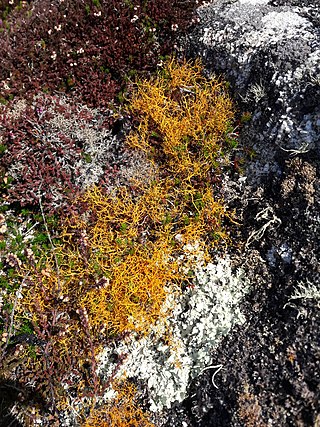
Teloschistes flavicans, also known as the golden hair-lichen, is a lichenized species of fungus in the genus Teloschistes, family Teloschistaceae. Recognized by its saffron-coloured pigmentation, this widespread fruticose lichen grows on rocks and branches of trees. It was first named and scientifically described in 1788 by Swedish botanist, Olof Swartz, who called it Lichen flavicans. Johannes Norman transferred it to the genus Teloschistes in 1852.

Squamulea is a genus of lichen-forming fungi in the family Teloschistaceae. It has 15 species. The genus was circumscribed in 2013 by Ulf Arup, Ulrik Søchting, and Patrik Frödén, with Squamulea subsoluta assigned as the type species. Five species were included in the original account of the genus. The genus name alludes to the squamulose growth form of most of its species. Squamulea has a worldwide distribution; when the genus was originally created, the centre of distribution was thought to be in southwestern North America.
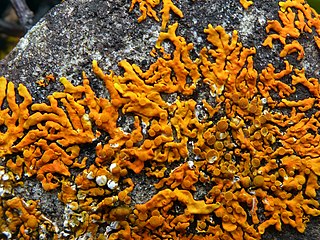
Dufourea is a genus of mostly foliose lichen species in the subfamily Xanthorioideae of the family Teloschistaceae. Species in the genus are found in the Southern Hemisphere.
Sirenophila is a genus of crustose lichens in the subfamily Teloschistoideae of the family Teloschistaceae. It has four species with an Australasian distribution.
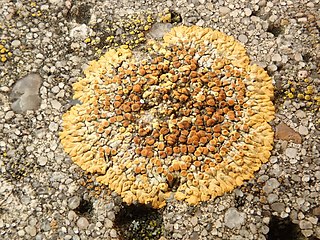
Calogaya pusilla is a species of saxicolous (rock-dwelling), crustose lichen in the family Teloschistaceae. It was originally formally described in 1852 by Italian lichenologist Abramo Bartolommeo Massalongo, who placed it in genus Physcia. The type specimen was collected in Veneto, Italy. It has undergone several changes of genus in its taxonomic history, including transfers to Caloplaca, Placodium, and Teloschistes. In 2013, it was placed in the newly circumscribed genus Calogaya.
Teloschistopsis is a genus of lichen-forming fungi in the family Teloschistaceae. It has three species.
Gondwania is a genus of lichen-forming fungi in the subfamily Xanthorioideae of the family Teloschistaceae. It has five species.
Usnochroma is a genus of lichen-forming fungi in the family Teloschistaceae. It has two species of crustose lichens. The genus was circumscribed in 2013 by lichenologists Ulrik Søchting, Ulf Arup, and Patrik Frödén, with Usnochroma carphineum assigned as the type species. The genus name refers to the yellowish-green colour of the thallus, which is caused by the substance usnic acid. Usnochroma species occur in Macaronesia, South Africa, the Mediterranean Basin, and Algeria.
Seirophora lacunosa is a species of saxicolous (rock-dwelling), fruticose lichen in the family Teloschistaceae. It is endemic to the semi-arid regions of southeastern Spain.
Xanthaptychia aurantiaca, the Arctic orangebush lichen, is a species of terricolous (ground-dwelling), fruticose lichen in the family Teloschistaceae. This small orange lichen is endemic to the Canadian Arctic and is known from a few scattered collections across this region. It was classified as an endangered species by the IUCN in 2020.
Scutaria is a single-species fungal genus in the family Teloschistaceae. It contains the species Scutaria andina, found in South America. The thallus of this lichen has a form that is intermediate between crustose and foliose.

Fallacinal is an organic compound in the structural class of chemicals known as anthraquinones. It is found in many species of the lichen family Teloschistaceae.

Fallacinol (teloschistin) is an organic compound in the structural class of chemicals known as anthraquinones. It is found in some lichens, particularly in the family Teloschistaceae, as well as a couple of plants and non lichen-forming fungi. In 1936, Japanese chemists isolated a pigment named fallacin from the lichen Oxneria fallax, which was later refined and assigned a tentative structural formula; by 1949, Indian chemists had isolated a substance from Teloschistes flavicans with an identical structural formula to fallacin. Later research further separated fallacin into two distinct pigments, fallacin-A and fallacin-B (fallacinol). The latter compound is also known as teloschistin due to its structural match with the substance isolated earlier.
Teloschistes spinosus is a species of corticolous (bark-dwelling), fruticose lichen in the family Teloschistaceae. It is found in Australia and New Zealand.
Teloschistes inflatus is a species of corticolous (bark-dwelling), fruticose lichen in the family Teloschistaceae. Found in Cape Province, South Africa, it was formally described as a new species in 2007 by the lichenologist Patrik Frödén.
